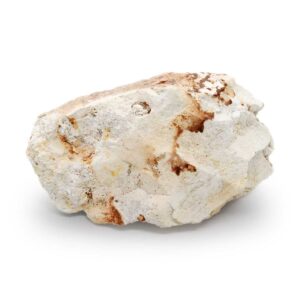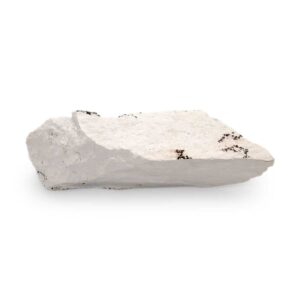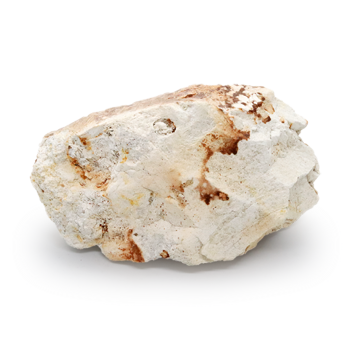

| No | Raw material name | SiO2 | Al2O | Fe2O3 | CaO | MgO | K2O | Na2O | Ig.loss |
|---|---|---|---|---|---|---|---|---|---|
| 11 | Amakusa Stone (Kumamoto) | 78.52 | 15.04 | 0.30 | 0.04 | – | 2.68 | 0.34 | 3.14 |
| 13 | Izumiyama Pottery Stone (Saga) | 80.39 | 13.92 | 0.39 | 0.03 | 0.04 | 2.72 | 0.56 | 2.40 |
| 20 | Taishu Nagaishi (Nagasaki) | 78.45 | 12.80 | 0.54 | 0.32 | 0.28 | 0.51 | 5.83 | 1.45 |
| 32 | Andesite (Saga) | 76.37 | 13.86 | 0.62 | 0.44 | 0.09 | 4.79 | 3.38 | 0.68 |
In the above examples of chemical analysis of ceramic raw materials, the chemical compositions of Amakusa stone and Izumiyama pottery stone are similar to those of Taishu feldspar and andesite, but their properties as raw materials are completely different. In the former, SiO2 and Al2O3 are converted to kaolinite, Al4Si4O10(OH)8, by hydrothermal action.
The presence of kaolinite makes the clay more viscous and more easily floats in water.
Amakusa stone and Izumiyama potter’s stone contain kaolin due to hydrothermal action, so they can be used to make earthenware on the potter’s wheel.
On the other hand, the andesite and andesite are not hydrothermally treated, so they cannot be connected to the clay and cannot even be formed on the potter’s wheel.
Therefore, in modern times, the former is used as a raw material for making base metal, while the latter is used as a raw material for making overglaze medicines.
When kaolinite is heated to a temperature of 450 degrees Celsius or higher, its crystalline body is broken down into its constituent elements SiO2 and Al2O3, respectively. The above examples of chemical analysis of ceramic raw materials are analyzed after firing, so they are different from kaolinite.
From now on, I would like to talk about what naturalized Korean potters brought to Japan before 1600.
Until then, Japanese pottery had a method of glazing, but the overglaze was made by either dissolving clay ash from the kiln in water or mixing clay ash with iron-rich clay. Pottery ranging from earthenware, Sue ware, Stoneware, and Koseto.
In the 1200s, a potter named Kato Shirozaakomon Keisho went to China to learn black glaze from Dogen Zen and returned to Japan to produce Kosedo and other wares.
The two main elements of Joseon ceramics were a Chinese mortar and the technique of water-sieving clay.
The technique involves using a mortar to break the clay or stone into small pieces, which are then sieved to separate them into clay and overglaze components.
The kaolinite I mentioned earlier is easily suspended in water, so the clay component is extracted, and particles with high silicic acid content, which tend to precipitate a little earlier, are extracted separately for use in the glaze.
(If too much kaolinite is added to the overglaze, transparency is lost, which is not good for the glaze.)
) To put it simply, in a rather large water jar, finely ground clay powder is dissolved in water and stirred, and then poured out into a large pool. Particles with more kaolinite are washed away and precipitate, while particles with less kaolinite and more silicate quickly precipitate and accumulate in the front. When the particles are separated, they are divided into clay and glaze. The glaze stone is not sticky, but the stickiness of the clay ash makes it useful as a glaze.
This technique was first used to produce Karatsu ware, which was then introduced to Mino by Kato Shirouemon Kage-nen and developed into Shino ware, Oribe ware, and Seto ware.
In Karatsu, white porcelain clay (ceramic stone) was discovered, and the Karatsu potters turned to porcelain, producing early Imari ware, which developed into Ko-Imari ware.
There are many volcanoes in Kyushu, and there are many veins of igneous rocks and kaolin ores here and there, which were produced by hydrothermal action, and there are many potteries in the Hizen area that were washed away and accumulated by natural weathering over many years. My guess is that the Izumiyama Pottery Stone Field and other mountains were larger mountains in ancient times, and that the pottery clay of Karatsu ware accumulated in the Imari and Karatsu areas after being washed away by the Matsuura River and other rivers due to weathering and wind and rain over many years. Since it is naturally weathered, it contains impurities (iron, etc.) and is colored, but its composition seems to be similar to that of Izumiyama Pottery Stone.
The technology developed in China was probably brought to Korea and brought to Japan. It is no exaggeration to say that the technology brought by the Joseon potters greatly changed the history of the ceramic industry in Japan.



